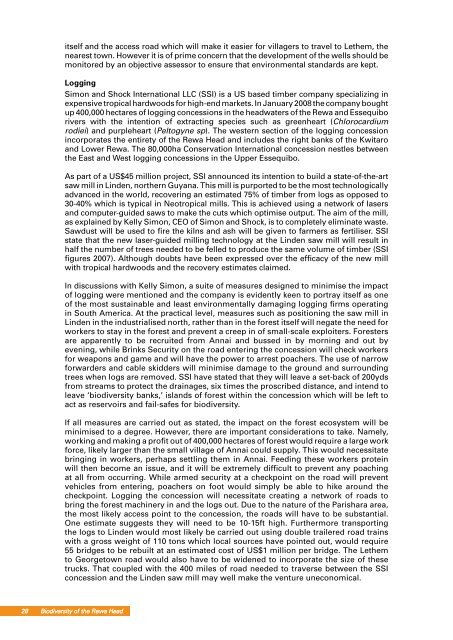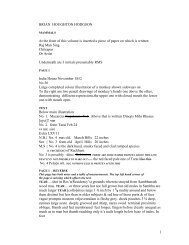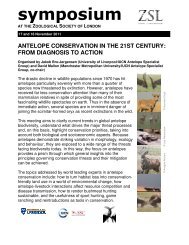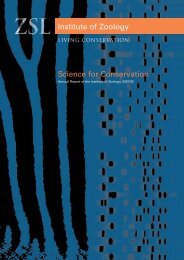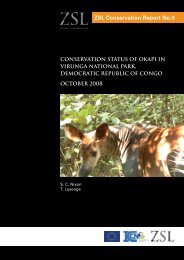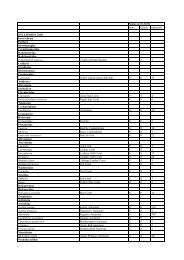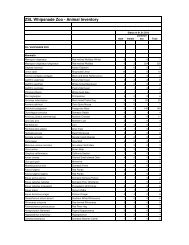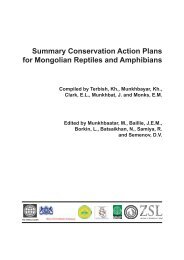Biodiversity of the Rewa Head B Zoological Society of London ...
Biodiversity of the Rewa Head B Zoological Society of London ...
Biodiversity of the Rewa Head B Zoological Society of London ...
You also want an ePaper? Increase the reach of your titles
YUMPU automatically turns print PDFs into web optimized ePapers that Google loves.
itself and <strong>the</strong> access road which will make it easier for villagers to travel to Le<strong>the</strong>m, <strong>the</strong><br />
nearest town. However it is <strong>of</strong> prime concern that <strong>the</strong> development <strong>of</strong> <strong>the</strong> wells should be<br />
monitored by an objective assessor to ensure that environmental standards are kept.<br />
Logging<br />
Simon and Shock International LLC (SSI) is a US based timber company specializing in<br />
expensive tropical hardwoods for high-end markets. In January 2008 <strong>the</strong> company bought<br />
up 400,000 hectares <strong>of</strong> logging concessions in <strong>the</strong> headwaters <strong>of</strong> <strong>the</strong> <strong>Rewa</strong> and Essequibo<br />
rivers with <strong>the</strong> intention <strong>of</strong> extracting species such as greenheart (Chlorocardium<br />
rodiei) and purpleheart (Peltogyne sp). The western section <strong>of</strong> <strong>the</strong> logging concession<br />
incorporates <strong>the</strong> entirety <strong>of</strong> <strong>the</strong> <strong>Rewa</strong> <strong>Head</strong> and includes <strong>the</strong> right banks <strong>of</strong> <strong>the</strong> Kwitaro<br />
and Lower <strong>Rewa</strong>. The 80,000ha Conservation International concession nestles between<br />
<strong>the</strong> East and West logging concessions in <strong>the</strong> Upper Essequibo.<br />
As part <strong>of</strong> a US$45 million project, SSI announced its intention to build a state-<strong>of</strong>-<strong>the</strong>-art<br />
saw mill in Linden, nor<strong>the</strong>rn Guyana. This mill is purported to be <strong>the</strong> most technologically<br />
advanced in <strong>the</strong> world, recovering an estimated 75% <strong>of</strong> timber from logs as opposed to<br />
30-40% which is typical in Neotropical mills. This is achieved using a network <strong>of</strong> lasers<br />
and computer-guided saws to make <strong>the</strong> cuts which optimise output. The aim <strong>of</strong> <strong>the</strong> mill,<br />
as explained by Kelly Simon, CEO <strong>of</strong> Simon and Shock, is to completely eliminate waste.<br />
Sawdust will be used to fire <strong>the</strong> kilns and ash will be given to farmers as fertiliser. SSI<br />
state that <strong>the</strong> new laser-guided milling technology at <strong>the</strong> Linden saw mill will result in<br />
half <strong>the</strong> number <strong>of</strong> trees needed to be felled to produce <strong>the</strong> same volume <strong>of</strong> timber (SSI<br />
figures 2007). Although doubts have been expressed over <strong>the</strong> efficacy <strong>of</strong> <strong>the</strong> new mill<br />
with tropical hardwoods and <strong>the</strong> recovery estimates claimed.<br />
In discussions with Kelly Simon, a suite <strong>of</strong> measures designed to minimise <strong>the</strong> impact<br />
<strong>of</strong> logging were mentioned and <strong>the</strong> company is evidently keen to portray itself as one<br />
<strong>of</strong> <strong>the</strong> most sustainable and least environmentally damaging logging firms operating<br />
in South America. At <strong>the</strong> practical level, measures such as positioning <strong>the</strong> saw mill in<br />
Linden in <strong>the</strong> industrialised north, ra<strong>the</strong>r than in <strong>the</strong> forest itself will negate <strong>the</strong> need for<br />
workers to stay in <strong>the</strong> forest and prevent a creep in <strong>of</strong> small-scale exploiters. Foresters<br />
are apparently to be recruited from Annai and bussed in by morning and out by<br />
evening, while Brinks Security on <strong>the</strong> road entering <strong>the</strong> concession will check workers<br />
for weapons and game and will have <strong>the</strong> power to arrest poachers. The use <strong>of</strong> narrow<br />
forwarders and cable skidders will minimise damage to <strong>the</strong> ground and surrounding<br />
trees when logs are removed. SSI have stated that <strong>the</strong>y will leave a set-back <strong>of</strong> 200yds<br />
from streams to protect <strong>the</strong> drainages, six times <strong>the</strong> proscribed distance, and intend to<br />
leave ‘biodiversity banks,’ islands <strong>of</strong> forest within <strong>the</strong> concession which will be left to<br />
act as reservoirs and fail-safes for biodiversity.<br />
If all measures are carried out as stated, <strong>the</strong> impact on <strong>the</strong> forest ecosystem will be<br />
minimised to a degree. However, <strong>the</strong>re are important considerations to take. Namely,<br />
working and making a pr<strong>of</strong>it out <strong>of</strong> 400,000 hectares <strong>of</strong> forest would require a large work<br />
force, likely larger than <strong>the</strong> small village <strong>of</strong> Annai could supply. This would necessitate<br />
bringing in workers, perhaps settling <strong>the</strong>m in Annai. Feeding <strong>the</strong>se workers protein<br />
will <strong>the</strong>n become an issue, and it will be extremely difficult to prevent any poaching<br />
at all from occurring. While armed security at a checkpoint on <strong>the</strong> road will prevent<br />
vehicles from entering, poachers on foot would simply be able to hike around <strong>the</strong><br />
checkpoint. Logging <strong>the</strong> concession will necessitate creating a network <strong>of</strong> roads to<br />
bring <strong>the</strong> forest machinery in and <strong>the</strong> logs out. Due to <strong>the</strong> nature <strong>of</strong> <strong>the</strong> Parishara area,<br />
<strong>the</strong> most likely access point to <strong>the</strong> concession, <strong>the</strong> roads will have to be substantial.<br />
One estimate suggests <strong>the</strong>y will need to be 10-15ft high. Fur<strong>the</strong>rmore transporting<br />
<strong>the</strong> logs to Linden would most likely be carried out using double trailered road trains<br />
with a gross weight <strong>of</strong> 110 tons which local sources have pointed out, would require<br />
55 bridges to be rebuilt at an estimated cost <strong>of</strong> US$1 million per bridge. The Le<strong>the</strong>m<br />
to Georgetown road would also have to be widened to incorporate <strong>the</strong> size <strong>of</strong> <strong>the</strong>se<br />
trucks. That coupled with <strong>the</strong> 400 miles <strong>of</strong> road needed to traverse between <strong>the</strong> SSI<br />
concession and <strong>the</strong> Linden saw mill may well make <strong>the</strong> venture uneconomical.<br />
28 <strong>Biodiversity</strong> <strong>of</strong> <strong>the</strong> <strong>Rewa</strong> <strong>Head</strong>


